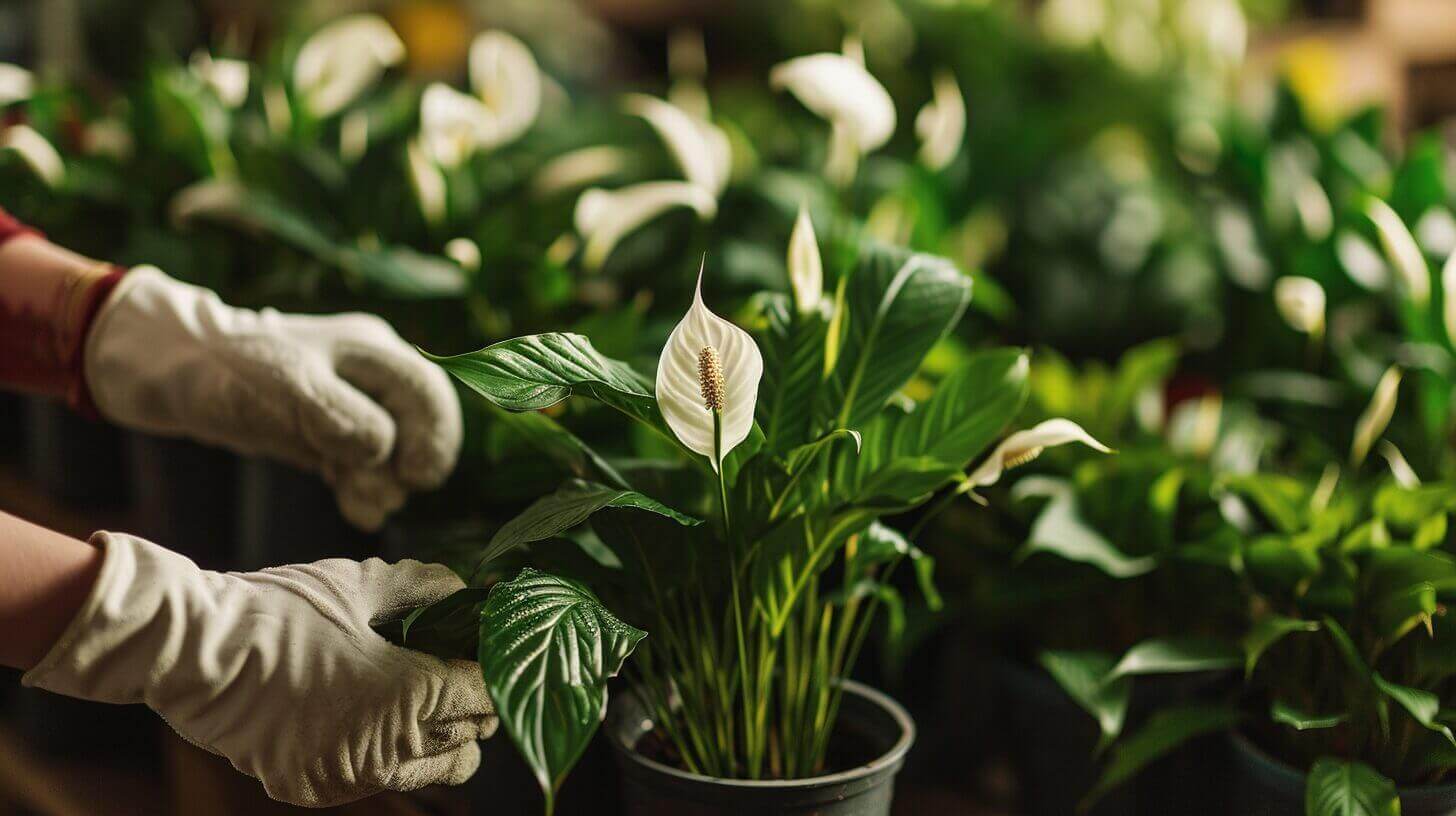How to Propagate Peace Lily Plant: Easy Step by Step Guide to Repot A Peace Lily
Key Takeaways
- Consider the plant’s growth stage and choose the right time for repotting
- Use essential tools such as a new pot, high-quality potting mix, trowel or gardening knife, watering can or spray bottle, and gardening gloves
- Prepare the peace lily by gently removing it from its current container, assessing the root system, trimming and removing old soil, and repotting it in fresh potting mix
- If propagating through offshoots, separate them carefully, ensure each has its own intact root system, and plant them in individual pots with well-draining soil
Choosing the Right Time and Tools for Repotting
When choosing the right time and tools for repotting, it is essential to consider the plant’s growth stage and use appropriate equipment for a successful transplant. Repotting is typically done when a plant has outgrown its current container or when the soil has become compacted and no longer provides adequate drainage. The best time to repot is during the plant’s active growing season, which is usually in the spring or early summer. This allows the plant to recover quickly from the transplant and establish new roots.
To ensure a successful repotting process, there are a few essential tools that you will need. Firstly, you will need a new pot that is slightly larger than the current one to accommodate the plant’s growing roots. Make sure the pot has drainage holes to prevent waterlogging.
Secondly, a high-quality potting mix is crucial for providing the plant with the necessary nutrients and drainage. You can either purchase a pre-mixed potting soil or create your own by combining equal parts of peat moss, perlite, and vermiculite.
Other essential tools include a trowel or a gardening knife for gently loosening the plant’s root ball and removing it from the old pot. Additionally, a watering can or a spray bottle is needed to moisten the potting mix after repotting. Finally, a pair of gardening gloves can protect your hands from any sharp edges or thorns.
Preparing the Peace Lily for Repotting
To properly prepare the peace lily for repotting, it is important to carefully assess the size and condition of its root system. This will help ensure the successful transplanting of the plant into a new pot.
The first step in preparing the peace lily for repotting is to gently remove it from its current container. Carefully turn the pot upside down and tap the sides to loosen the root ball.
Once the plant is out of the pot, take a close look at the roots. If they are tightly wound or circling around the root ball, it is necessary to trim them. Use a sharp, clean pair of scissors or pruners to trim away any damaged or extra-long roots. This will promote healthy growth and prevent root-bound issues in the new pot.
After trimming, it is important to remove the old soil from the roots. Gently shake the plant to loosen the soil, or use your fingers to carefully untangle the roots.
Once the roots are free of old soil, the peace lily is ready to be repotted in fresh, well-draining potting mix.
Dividing the Peace Lily: Separating the Offshoots
How can the offshoots of a peace lily be separated to promote new growth and propagate the plant? Propagating peace lilies through offshoot separation is a simple and effective method to expand your plant collection and share its beauty with others. Offshoots are small plantlets that grow from the base of the main plant and can be easily separated to create new individual plants.
To separate the offshoots, start by gently removing the peace lily from its pot and carefully separate the offshoots from the main plant. It is important to ensure that each offshoot has its own root system intact. Gently untangle the roots if necessary, being careful not to damage them.
Once the offshoots are separated, plant them in individual pots filled with well-draining potting soil. Make sure to provide them with adequate water and indirect sunlight to encourage their growth.
Once the offshoots have developed a strong root system and are showing signs of new growth, they can be repotted into larger containers. This leads us to the next step in propagating peace lilies: selecting the right pot and soil.
Repotting the Peace Lily: Selecting the Right Pot and Soil
The selection of an appropriate pot and soil is crucial when repotting a peace lily to ensure its healthy growth and development. When selecting a pot, it is important to choose one that is slightly larger than the current pot, allowing room for the roots to grow. Too small of a pot can restrict root growth, while too large of a pot can lead to over-watering and root rot. Additionally, the pot should have drainage holes to prevent water from pooling at the bottom and causing root rot.
In terms of soil, a well-draining potting mix is essential for the peace lily’s overall health. This type of soil allows excess water to drain away, preventing waterlogged roots. A good potting mix can be made by combining equal parts of peat moss, perlite, and a high-quality potting soil. This mixture provides the peace lily with the right balance of moisture retention and drainage.
When repotting, it is important to gently remove the peace lily from its current pot and carefully loosen the roots. Place the plant in the new pot, ensuring that the roots are spread evenly. Fill the rest of the pot with the well-draining soil mix, making sure not to bury the plant too deep. Finally, water the peace lily thoroughly and place it in a location with bright, indirect light.
Caring for Newly Repotted Peace Lilies: Watering, Light, and Maintenance
After repotting peace lilies, it is crucial to monitor their watering needs and provide them with adequate light and maintenance for optimal growth. Peace lilies are known for their lush green foliage and striking white flowers, but in order to ensure their health and longevity, proper care is essential.
When it comes to watering peace lilies, frequency is key. These plants prefer to be kept evenly moist, but not overly saturated. It is important to check the moisture level of the soil before watering. Stick your finger about an inch into the soil, and if it feels dry, it’s time to water. Generally, peace lilies require watering every 7-10 days, but this may vary depending on factors such as temperature and humidity.
In terms of sunlight requirements, peace lilies thrive in bright, indirect light. They should be placed near a window where they can receive filtered sunlight throughout the day. Direct sunlight can scorch their leaves, so it’s best to avoid placing them in direct sun.
Maintenance for peace lilies includes regular dusting of their leaves to keep them clean and free from dust build-up. Additionally, it is important to remove any yellow or brown leaves promptly to maintain the plant’s overall health and appearance.
Frequently Asked Questions
Can Peace Lily Plants Be Propagated with Less Sunlight?
Peace lily plants can indeed be propagated with less sunlight. Despite their typical sunlight requirements for peace lily, these hardy plants can tolerate low-light conditions. To successfully propagate them, ensure that the cuttings have a sufficient number of healthy leaves and give them a warm and moist environment.
What Is the Ideal Size for a Peace Lily Plant When Repotting?
When repotting a peace lily, it is important to consider the ideal size for the plant. The peace lily height plays a crucial role in determining when it needs to be repotted. Generally, it is recommended to repot a peace lily when it outgrows its current pot or when its roots start to become too crowded. This ensures the plant has enough room to grow and thrive.
Can Propagating a Peace Lily Help Stimulate Blooming?
Propagating a Peace Lily is an effective technique for maximizing peace lily blooms. By dividing the plant’s root ball and creating new plants, you not only propagate more lilies but also encourage blooming. This process enhances the plant’s energy allocation, triggering an increase in flower production. So, if you want to enjoy abundant blooms, consider propagating your Peace Lily.
How Long Does It Take for a Peace Lily to Recover After Repotting?
The recovery time for a peace lily after repotting can vary depending on various factors such as the health and age of the plant, environmental conditions, and the extent of root disturbance during repotting. Generally, it may take a few weeks for the plant to fully recover and show signs of healthy growth.
Signs of a healthy repotted peace lily include new leaf development, increased overall vitality, and a stable root system. Providing proper care, including adequate watering and light, will help expedite the recovery process.
Can I Propagate a Peace Lily by Leaf Cuttings Instead of Dividing the Offshoots?
Leaf propagation of peace lilies is an alternative method for propagating these popular houseplants. Instead of dividing offshoots, you can take leaf cuttings to create new plants.
This method involves carefully removing a healthy leaf from the mother plant and placing it in a suitable growing medium. Over time, the leaf will develop roots and eventually grow into a new peace lily.
Leaf propagation offers a different approach to expanding your collection of peace lilies and can be an exciting experiment for plant enthusiasts.
When is the best time to repot a peace lily plant?
The best time to repot a peace lily is when you notice that the plant may be outgrowing its current pot. This is usually evident when you see roots growing out of the bottom of the pot or when the surface of the soil dries out quickly after watering.
How do I know if my peace lily needs repotting?
If your peace lily has grown significantly or if it’s time to repot, you may notice signs such as yellow leaves, slow growth, or water running straight through the pot. These are signs that your plant needs a larger container.
What are the steps for repotting a peace lily?
Repotting a peace lily involves several steps. First, remove the plant from its pot. Then, gently divide the plant if it’s mature and you want to propagate it. Place the peace lily in a new pot with fresh soil around it. Make sure to water it thoroughly after repotting.
How do I propagate a peace lily?
Propagating a peace lily is done by division. When you’re repotting, you can divide the plant into smaller sections and plant each one in a new container.
Can I propagate a peace lily in water?
Yes, you can propagate a peace lily in water. After dividing the plant, place it in a container with water. Make sure to change the water regularly to prevent root rot.
What type of soil mix is best for peace lilies?
Peace lilies prefer a well-draining soil mix. A good mix can include peat moss, perlite, and vermiculite.
How do I care for my peace lily after repotting?
After repotting your peace lily, place it in a location with indirect light and keep the soil consistently moist. Be careful not to overwater as this can lead to root rot.
What should I do if my peace lily experiences transplant shock?
If your peace lily experiences transplant shock after repotting, try to keep its environment stable and avoid any drastic changes in light or temperature. Continue to care for it as usual and it should recover with time.
Are peace lilies suitable as houseplants?
Yes, peace lilies make excellent houseplants. They are known for their ability to clean the air and they can thrive in low light conditions, making them perfect for indoor living spaces.
How often do I need to water my peace lily?
Peace lilies need to be watered regularly, but the frequency depends on the conditions in your home. As a general rule, water when the top inch of soil feels dry to the touch.







